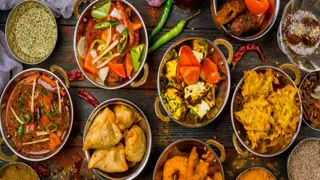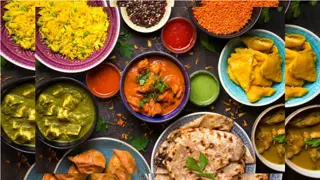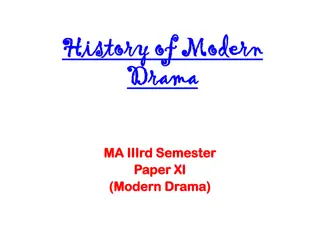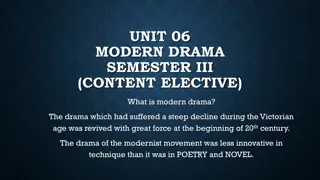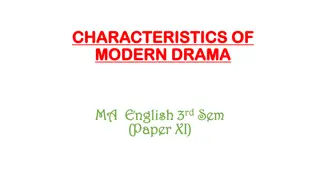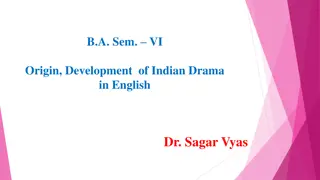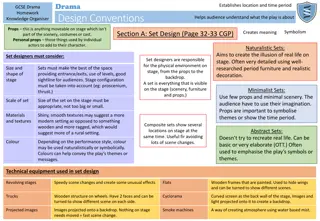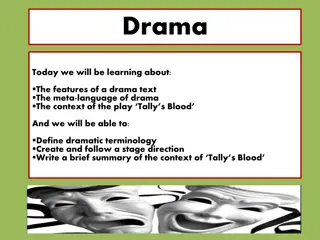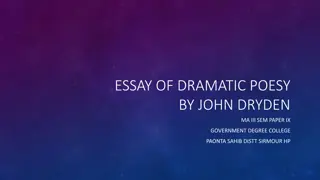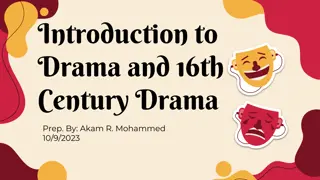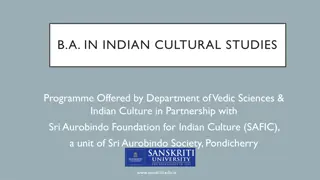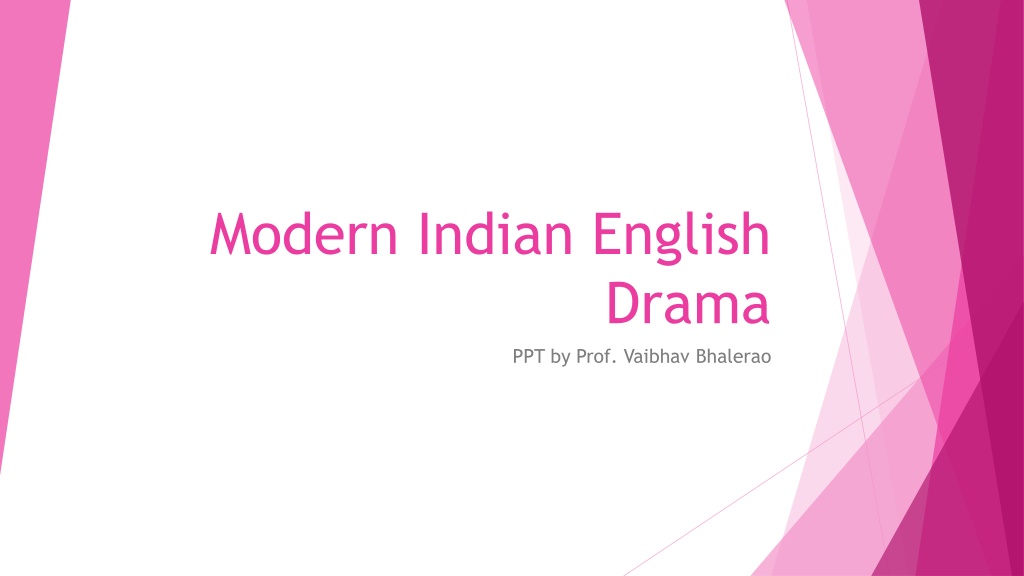
Exploring Modern Indian English Drama Through the Ages
Uncover the evolution of Indian English drama from ancient times to the modern era. Discover the impact of cultural changes on the development of drama in Indian society and its relationship with Western influences.
Download Presentation

Please find below an Image/Link to download the presentation.
The content on the website is provided AS IS for your information and personal use only. It may not be sold, licensed, or shared on other websites without obtaining consent from the author. If you encounter any issues during the download, it is possible that the publisher has removed the file from their server.
You are allowed to download the files provided on this website for personal or commercial use, subject to the condition that they are used lawfully. All files are the property of their respective owners.
The content on the website is provided AS IS for your information and personal use only. It may not be sold, licensed, or shared on other websites without obtaining consent from the author.
E N D
Presentation Transcript
Modern Indian English Drama PPT by Prof. Vaibhav Bhalerao
Drama is an important cultural performance of a society. Drama not only registers but also manifests the changes (social, political or cultural) the society undergoes. enable to reconstruct the history, comprehend its identity. Modern Indian English drama can be taken into consideration to conceive the cultural identity of the society to which it belongs. Contemporary urban, middle-class English speaking stratum of Indian society is the society to which it belongs. Thus, the study of drama would understand the society and When we consider Indian drama, obviously we are reminded of ancient drama. Ancient Sanskrit drama was so popular that the world recognizes India with ancient drama and the critical treatise associated with that, Natyasastra. Let us now do a critical scrutiny of the journey of India drama from ancient times to modern times.
Natyasastra is a complete book of performance. aesthetics details all kinds of performance and according to this book, drama is the prominent form followed Natyasastra in every respect. Natyasastra instructs right from the construction of the stage, the place where different artisans are supposed to sit, the direction of each artisan etc. all these details are a part of the construction of the stage and setting. plot or itivrtha is a significant aspect of a drama. In chapter XXI entitled Sandhyanga Vikalpa, Bharata mentions all the details of the plot and its development. This book of Indian of performance. Ancient drama The selection of the Among many other disciplinary guide lines, selection of characters is a significant one. In chapter XXXIV in Natyasastra types of characters are discussed. There are three kinds of characters (male and female) in a play, Uttama(superior), and Madhyama(middling). Adhama(inferior)
Drama in India is revoked during the British rule. Though vernacular drama became popular, English drama also saw the beginning during this time. Thus English theatre in India is essentially an 18th century phenomenon that began with a purpose of entertaining the British who came to serve British administration in India. companies performed comedies, farces and operas in major urban Indian spaces where the British used to live. European touring Indians trained through British education system took interest in this art form. Their efforts resulted in the form of Indian English drama which grew as an off-shoot in the spread of nationalism. When these Indians wished to express themselves through the stage plays, their immediate role model was the European play presented in India. Ever since those times, Indian English drama was striving to grow as an independent genre of Indian English Literature.
Indian English drama thus began its primary development following the European drama. A question that triggers our attention is, though Indians have had a well developed and well sophisticated theatre history why the ancient drama failed to attract the Indians? the immediate availability of a role model and secondly the cultural changes already taking place in urban India. These two factors influenced the Indian English drama to follow the western drama mainly in the aspects of stage and setting. One of the main reasons is, the living style, clothing, commutation, technological development, home keeping - many such aspects of urban Indian living were influenced by the British. the stage construction, setting was immediately accepted but English language was not accepted as language of communication in Indian home till the recent times. Natural conversation is the significant feature and vital necessity of drama. M.K. Naik observes this fact and writes. The reasons may be, firstly Thus One major hurdle which the playwright in English is supposed to encounter is that of language. It is often said that we have so a few actable English plays, because a dialogue in English between Indians will not sound convincing, except when the characters are drawn from an urban, sophisticated milieu, or actually Anglo Indians whose mother tongue is (supposed to be) English.
The Indian English drama during colonial rule and in post-colonial India depicts the cultural changes sealed into Indian culture. As observed earlier, the revoked Indian drama did not follow ancient drama but followed modern, Western drama. cultural changes that initiated with the advent of Britishers are quite evident in the stage, setting, costume (trousers and shirt), music and other architechtonics of theatre. But the subjects, themes, issues, characters, actors were Indian, indicating the hybrid identity of this genre. The Neither the dramatic text nor the theatrical text followed the instructions of ancient Sanskrit drama but still this genre belongs to India. identity is being carried by this genre of Indian English Literature. gradually developed on these lines of hybridity to this present form which takes its identity with the cultural identity of the society to which it belongs. This unique hybrid This genre
Contemporary Indian English drama takes up the issues related to the urban, middle class, English speaking society which is undergoing a noticeable cultural change. Issues like marital infidelity, homosexuality licentiousness are common place subjects of plays ex: Do the Needful, On a Muggy Night in Mumbai, The Harvest etc. The necessity to focus on the conflicts in the lives of contemporary Indians springs from the complex situation in which he/she exists. Socio-cultural scenario of India was affected to a great extent by the colonial rule. Traditional Indian society which was inherently hierarchized was further stratified with the master-servant paradigm of colonial rule. This resulted in new personality types marked by clusters of characteristic traits such as submissiveness, psychofancy, confidence. Therefore in post-independence India, an individual is caught in complex situation that is a result of the combination of traditional Indian culture and the culture of the British. His/her attempt to break these shackles at familial, social and cultural levels becomes significant feature of contemporary urban Indian life. In terms of values, individuals [especially urban Indians] in India are highly influenced by the new money power. Guru Charan Das in India Unbound discusses the new middle class at length and he writes, ----- it has no clear ethos beyond money and the here and now. It has no heroes other than cricketers and Bollywood stars. The soul has gone out of the old merit middle class, and an aggressive capitalism has replaced the socialist idealism of the youth [328] Issues relating to this become the themes of the plays in post-colonial India. dependence and lack of self-
he plot and construction of dramatic text of these plays follows modern western drama and not ancient Indian drama. belong to the society to which these plays are meant for and they are ordinary, middle class urban Indians. Their emotions, body language, in terms of values, ideas and ideals are exhibiting the cultural changes. The stage and setting in contemporary India has undergone a considerable development. The technological outburst has effected the stage setting. settings and other developments, the typical urban, middleclass Indian home on the stage would focus on the influence of the west in home keeping. The characters of these plays generally Apart from lighting techniques, stylish The costume, music also shows the blend of Indian as well as western culture s presence. Thus the study of various architechtonics of these plays confirms that the culture they exhibit is neither traditional Indian nor complete western. It is the traditional Indian Culture [under strong influence of modern western culture], manifesting a unique post-colonial culture which is attempting to renounce colonial influence. The influence of Western modernism seems to sway the traditional Indianism. But the traditional Indianism is so dominant and intimidating that the root metaphors of modernism could not consolidate in Indian space.
The peculiar culture of urban India cannot be called as western modernism. But it is typically Indian modernism which may lead towards western modernism. Therefore the socio-cultural changes that took place in India shaped the present form of Indian drama (in particular English drama) which does not have any resemblances of its predecessor. contemporary Indian English drama is post-colonial in the sense of its cultural identity. This genre follows the modern western drama in more than one aspect and manicured a significant paradigmatic shift from ancient Indian drama. This demonstrates that the societal changes are capable of organizing the art forms and drama being one of the prominent literary genres, evidently manifested the changes. The


